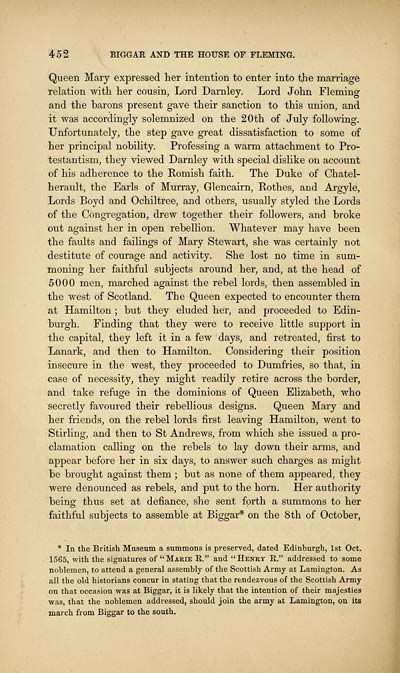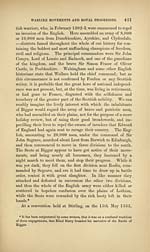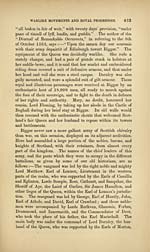Biggar and the House of Fleming
(482) Page 464
Download files
Complete book:
Individual page:
Thumbnail gallery: Grid view | List view

452 BIGGAR AND THE HOUSE OF FLEMING.
Queen Mary expressed her intention to enter into the marriage
relation with her cousin, Lord Darnley. Lord John Fleming
and the barons present gave their sanction to this union, and
it was accordingly solemnized on the 20th of July following.
Unfortunately, the step gave great dissatisfaction to some of
her principal nobility. Professing a warm attachment to Pro-
testantism, they viewed Darnley with special dislike on account
of his adherence to the Komish faith. The Duke of Chatel-
herault, the Earls of Murray, Glencairn, Rothes, and Argyle,
Lords Boyd and Ochiltree, and others, usually styled the Lords
of the Congregation, drew together their followers, and broke
out against her in open rebellion. Whatever may have been
the faults and failings of Mary Stewart, she was certainly not
destitute of courage and activity. She lost no time in sum-
moning her faithful subjects around her, and, at the head of
5000 men, marched against the rebel lords, then assembled in
the west of Scotland. The Queen expected to encounter them
at Hamilton ; but they eluded her, and proceeded to Edin-
burgh. Finding that they were to receive little support in
the capital, they left it in a few days, and retreated, first to
Lanark, and then to Hamilton. Considering their position
insecure in the west, they proceeded to Dumfries, so that, in
case of necessity, they might readily retire across the border,
and take refuge in the dominions of Queen Elizabeth, who
secretly favoured their rebellious designs. Queen Mary and
her friends, on the rebel lords first leaving Hamilton, went to
Stirling, and then to St Andrews, from which she issued a pro-
clamation calling on the rebels to lay down their arms, and
appear before her in six days, to answer such charges as might
be brought against them ; but as none of them appeared, they
were denounced as rebels, and put to the horn. Her authority
being thus set at defiance, she sent forth a summons to her
faithful subjects to assemble at Biggar* on the 8th of October,
* In the British Museum a summons is preserved, dated Edinburgh, 1st Oct.
1565, with the signatures of "Marie R." and "Henry R." addressed to some
noblemen, to attend a general assembly of the Scottish Army at Lamington. As
all the old historians concur in stating that the rendezvous of the Scottish Army
on that occasion was at Biggar, it is likely that the intention of their majesties
was, that the noblemen addressed, should join the army at Lamington, on its
march from Biggar to the south.
Queen Mary expressed her intention to enter into the marriage
relation with her cousin, Lord Darnley. Lord John Fleming
and the barons present gave their sanction to this union, and
it was accordingly solemnized on the 20th of July following.
Unfortunately, the step gave great dissatisfaction to some of
her principal nobility. Professing a warm attachment to Pro-
testantism, they viewed Darnley with special dislike on account
of his adherence to the Komish faith. The Duke of Chatel-
herault, the Earls of Murray, Glencairn, Rothes, and Argyle,
Lords Boyd and Ochiltree, and others, usually styled the Lords
of the Congregation, drew together their followers, and broke
out against her in open rebellion. Whatever may have been
the faults and failings of Mary Stewart, she was certainly not
destitute of courage and activity. She lost no time in sum-
moning her faithful subjects around her, and, at the head of
5000 men, marched against the rebel lords, then assembled in
the west of Scotland. The Queen expected to encounter them
at Hamilton ; but they eluded her, and proceeded to Edin-
burgh. Finding that they were to receive little support in
the capital, they left it in a few days, and retreated, first to
Lanark, and then to Hamilton. Considering their position
insecure in the west, they proceeded to Dumfries, so that, in
case of necessity, they might readily retire across the border,
and take refuge in the dominions of Queen Elizabeth, who
secretly favoured their rebellious designs. Queen Mary and
her friends, on the rebel lords first leaving Hamilton, went to
Stirling, and then to St Andrews, from which she issued a pro-
clamation calling on the rebels to lay down their arms, and
appear before her in six days, to answer such charges as might
be brought against them ; but as none of them appeared, they
were denounced as rebels, and put to the horn. Her authority
being thus set at defiance, she sent forth a summons to her
faithful subjects to assemble at Biggar* on the 8th of October,
* In the British Museum a summons is preserved, dated Edinburgh, 1st Oct.
1565, with the signatures of "Marie R." and "Henry R." addressed to some
noblemen, to attend a general assembly of the Scottish Army at Lamington. As
all the old historians concur in stating that the rendezvous of the Scottish Army
on that occasion was at Biggar, it is likely that the intention of their majesties
was, that the noblemen addressed, should join the army at Lamington, on its
march from Biggar to the south.
Set display mode to:
![]() Universal Viewer |
Universal Viewer | ![]() Mirador |
Large image | Transcription
Mirador |
Large image | Transcription
Images and transcriptions on this page, including medium image downloads, may be used under the Creative Commons Attribution 4.0 International Licence unless otherwise stated. ![]()
| Histories of Scottish families > Biggar and the House of Fleming > (482) Page 464 |
|---|
| Permanent URL | https://digital.nls.uk/94845066 |
|---|
| Description | A selection of almost 400 printed items relating to the history of Scottish families, mostly dating from the 19th and early 20th centuries. Includes memoirs, genealogies and clan histories, with a few produced by emigrant families. The earliest family history goes back to AD 916. |
|---|

